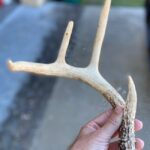A Roman nose, or Aquiline nose, is a recognizable facial feature that has been observed in many species, like humans, guinea pigs, horses, and deer.
‘Aquiline’ comes from the Latin term meaning eagle-like, describing the nose’s curved appearance like an eagle’s beak. The Roman nose is a centuries-old European term, describing the trait as noble and dignified.
With that being said, let’s look into the causes and history of Roman nose deer.
Table of Contents
- What is a Roman Nose on a Deer?
- History and Meaning
- Causes For Roman Nose Deer
- Nothing to Worry About
- A Distinct Feature
What is a Roman Nose on a Deer?
The exact cause for Roman noses on deer is unclear.
There are a few ideas about where the curved snout with an apparent bump in the nose comes from, but there is no one proven explanation. A Roman nose can be the result of age, because of an injury, or a genetic trait.

History and Meaning
The term Roman nose comes from Western scientists and writers from the post-Enlightenment and Victorian eras.
The term originated from studying statues and sculptures from the ancient Greco-Roman times.
From studying these eras of history and art, sculptures of those with prominent hooked noses were associated with nobility, intelligence, and social status.
The Roman nose became the ideal facial type of the time, as people would use that as a sign of superiority.
The meaning evolved to also be a sign of a great warrior. During the Indian Wars of America in the 1860s, the Cheyenne Chief, Henry C. Roman Nose was revered as a fierce warrior and great leader, contributing to attributes given to the term.
See also: Why Are Deer So Dumb? (Or Are They…?)
Causes For Roman Nose Deer
These alleged qualities have led to humans attributing the term to deer, who for various reasons, also occasionally grow to have curved or hooked Roman noses.
As a common prey for hunters for many thousands of years, humans attribute human qualities to deer.
Deer with Roman noses were seen as smart, cunning, and mature, making them worthy adversaries, giving significance to the hunt and pride to the hunter.
Since most deer species are not domesticated, genetic studies are rare.
So we may not know the exact cause or original source of the Roman nose, but given how prevalent it is in the deer population with little negative effects, there are multiple, reasonable possibilities.
Age

While not being definitive, one of the most common theories of Roman noses on deer is old age. Many hunters have noted that the older a deer gets, the more common Roman noses are. This could be due to a few factors.
As deer grow and get older, as with humans, their features become more pronounced and permanent.
The skull and bones of older deer become harder and thicker, so any curvature of the snout will become more apparent.
Related: Coues Deer vs Whitetail Deer: Differences And Comparison.
Injury
Age could also play a factor if this theory is to be believed; that the Roman nose could be the cause of an injury to the deer.
Much like the way a human’s broken nose does not heal to become straight again, the curved nose could be because it has healed crookedly.
Some species of deer, specifically bucks, fight other deer over territory and during mating season. One of a buck’s primary attacks is to charge forward and attack with its antlers. A nose injury from this is certainly possible.
Older bucks have gone through numerous mating seasons and can go through countless fights like this, which could explain why the Roman nose is more noticeable in older deer.
You may also like: What Time Of Night Are Deer Most Active?
Genetics
Another common and logical theory is that also like in humans, the Roman nose is a result of genetics. It could simply be a hereditary trait that was passed down to offspring from mating deer who had Roman noses.
Nothing to Worry About
Not all deer have or develop a Roman nose, but they have been observed in many different species and on both sexes.
Roman noses have been noticed on whitetail, coues, mule deer, and blacktails.
The nose feature does not appear to be a sign of any genetic abnormality or cause any adverse effects. Deer with Roman noses appear to see and smell just as fine as others, with the snout shape not affecting these senses.
However, if a curved or crooked snout is the result of an injury or a genetic deformity, this could impact the deer’s quality of life, creating breathing problems or internal bleeding.
This, however, would likely mean the deer’s death and not result in healing into the Roman nose shape.
A Distinct Feature
While there are some correlations between a deer’s age, its life, its traits, and whether or not it has a Roman nose, nothing has been definitively proven.
However, this just adds to the uniqueness and charisma of deer. They each have their own personalities and traits, much like ourselves.






